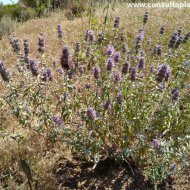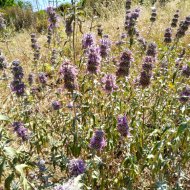Care of the shrub Salvia leucophylla or Purple sage |
|
The genus Salvia, family Lamiaceae, includes 1,000 species of shrubs and herbaceous plants native to Asia, Africa, the Mediterranean region, and Central and South America. Some species are: Salvia leucophylla, Salvia vaseyi, Salvia elegans, Salvia fruticosa, Salvia officinalis, Salvia splendens, Salvia scabra, Salvia nemorosa, Salvia namaensis, Salvia microphylla, Salvia mexicana, Salvia mellifera, Salvia leucantha, Salvia lanceolata, Salvia guaranitica, Salvia greggii, Salvia farinacea, Salvia disermas, Salvia canariensis, Salvia aurea, Salvia apiana, Salvia africana, Salvia sclarea. Common names: Purple sage, Gray sage, San Luis purple sage. This species is native to California and Baja California. They are evergreen shrubs that reach 1.5 meters (4.9 feet) in height and width. The velvety, lanceolate, aromatic leaves are greyish-green, turning silvery-gray with age. The scented purple or blue flowers appear in erect inflorescences up to 20 cm (7.87") long. They bloom summer and fall. They are used in borders, in rockeries, on dry and sunny slopes, in gardens of aromatic plants, to form low hedges and in pots for terraces and patios. They are ideal for Mediterranean coastal gardens. They attract butterflies and bees. Salvia leucophylla needs full sun exposure and a warm, dry climate. Frost resistant to -10 ºC (14 ºF). They grow in any type of soil that has excellent drainage. Water moderately, waiting for the substrate to dry completely. They resist drought very well when established. They do not need fertilizer. Prune the withered inflorescences to maintain a compact habit. They are plants resistant to the usual pests and diseases. They are propagated from seeds sown in spring. |
Images of the shrub Salvia leucophylla or Purple sage |
Find plants
Salvia leucophylla or Purple sage | Care and Growing
© 2024 FavThemes


